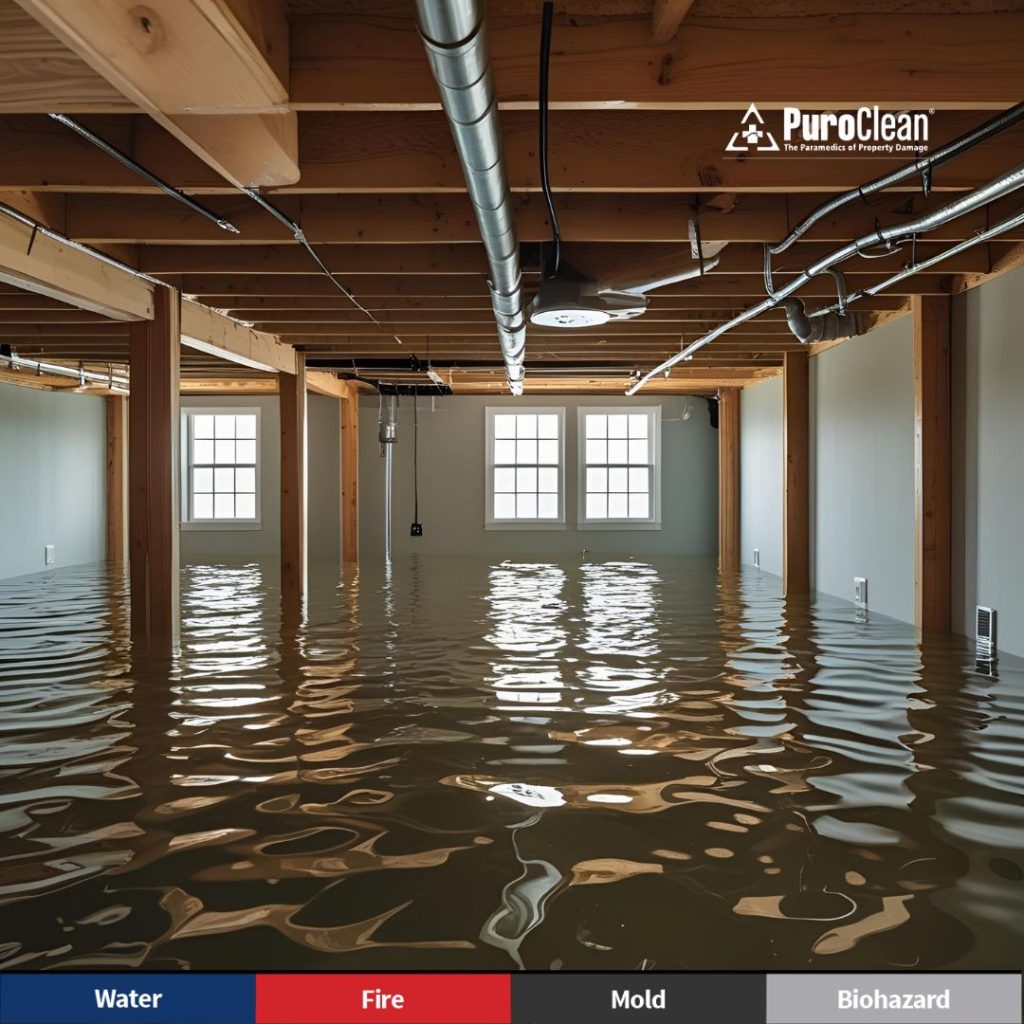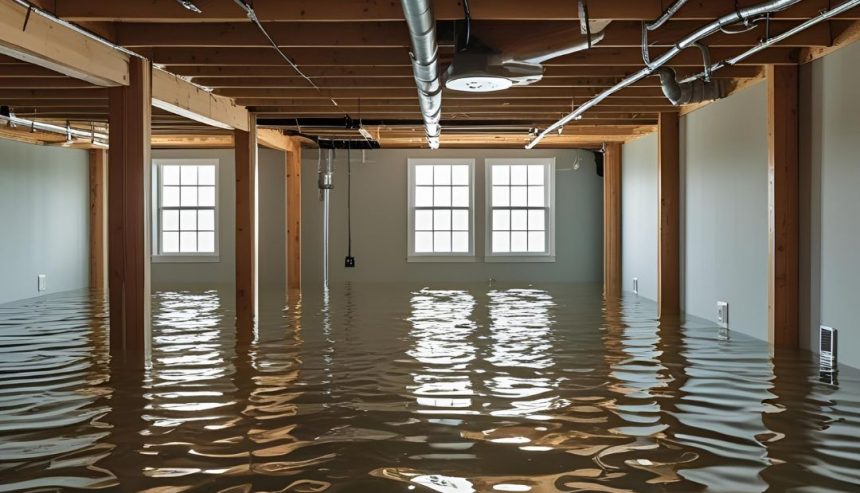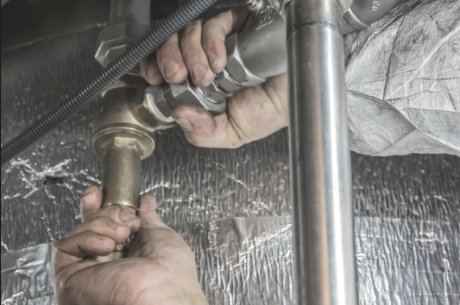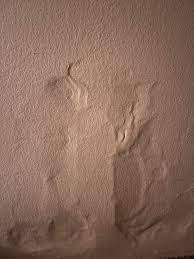When basement flooding disrupts your life in Lawrenceville or Gwinnett County, knowing what to expect gives you confidence in recovery. From inspection to restoration, here’s how PuroClean of Lawrenceville tackles basement flood cleanup with precision, care, and speed.

Table of Contents
1. Initial Assessment & Water Damage Inspection Before Basement Flood Cleanup
Our process begins with a full-site assessment by certified technicians:
- We classify the water type—clean, gray, or black water—to determine risk and safety protocols.
- We inspect flooring, walls, and insulation using non-invasive moisture meters and infrared thermal imaging, which detect hidden water behind walls or under flooring even if carpet looks dry. Drywall may absorb water up to 12 inches high, even when standing water is minimal.
- We identify structural concerns, electrical hazards, and assess whether drywall and insulation must be removed for thorough drying.
Local relevance: Being familiar with Gwinnett County’s clay soil, grading issues, and typical sump pump failures helps us accurately pinpoint why your basement flooded in the first place before emergency basement flood cleanup begins.
2. Emergency Water Removal & Extraction
Once assessment is complete, rapid water removal begins:
- For significant water, we use 2-inch submersible pumps or truck-mounted extractors to clear standing water.
- For residual or trapped water, professional-grade wet/dry vacs ensure your floors and baseboards are thoroughly dried.
- Our team removes any wet furniture, carpets, padding, and baseboards—not only to dry them properly but also to allow air flow into wall cavities and floor assemblies.
Local relevance: We address common Lawrenceville issues like overflow from sump failures during heavy summer storms typical to Gwinnett’s watershed drainage system. this process is essential to basement flood cleanup.
3. Removal of Damaged Materials & Content Protection
To prevent mold and lingering moisture:
- We remove porous building materials—using humidity-resistant drywall and insulation when rebuilding is needed.
- We punch small holes at baseboards to let trapped damp air escape from wall cavities.
- Belongings that can’t be dried—rugs, mattresses, upholstered furniture are carefully removed and documented for insurance purposes.
4. Structural Drying, Dehumidification & Monitoring
Drying is critical to stopping mold before it starts:
- Industrial air movers, LGR or desiccant dehumidifiers, and optional convectant drying systems are deployed—capable of reducing relative humidity to below 40–50% within days.
- Our crew monitors and adjusts equipment daily, checking temperature and humidity readings to maintain ideal drying conditions—this usually takes 3–5 days, depending on damage severity.
- We continually verify moisture levels with testing tools to prevent hidden damp spots behind walls or below floors.
5. Cleaning, Disinfection & Mold Inhibition
Once dry, we thoroughly clean:
- Surfaces are washed with EPA-approved antimicrobial solutions—not bleach—for safety and effectiveness in killing mold spores and bacteria.
- HEPA air scrubbers may be deployed to remove airborne particulates and odors.
- Mold-inhibiting agents are applied to structural surfaces to prevent future growth.
6. Final Inspection & Reconstruction
Before closing out mitigation:
- We verify all materials have reached original moisture levels and ensure environmental conditions are restored.
- When required, our team replaces drywall, refloors, insulating panels, and repaints affected areas—utilizing mold-resistant materials where possible to enhance durability.
- We coordinate inspection walkthroughs with insurance adjusters to streamline claim processing.
7. Local Expertise, Insurance Coordination & Follow-Up
What sets us apart for basement flood cleanup:
- Local knowledge of Lawrenceville weather patterns, flood zones, Gwinnett drainage issues, and common causes like clogged gutters or aging sump systems ensures precision in both cleanup and prevention.
- We partner with homeowners and businesses to maintain smooth insurance communication handling documentation, estimates, and liaison with adjusters from start to finish.
- Our follow-up includes guidance on future flood prevention—like gutter maintenance, lawn grading, sump pump installation, and French drains suited to Gwinnett homes.
✅ Why This Process Protects You & Your Home
- Mold can begin growing within 24 to 48 hours—prompt intervention reduces long-term damage.
- Moisture lingering behind walls or below flooring can lead to structural rot or air quality issues.
- Incomplete dry-out often leads to recurring issues; professional remediation ensures you’re dry, clean, and safe.
- Proper documentation and mitigation reduce out-of-pocket costs and ease the insurance claims process after basement flood cleanup.
Serving Lawrenceville & Gwinnett County
At PuroClean of Lawrenceville, we act fast and locally:
- Certified experts trained in the latest IICRC S500 water damage protocol
- Rapid response 24/7 across Lawrenceville, Duluth, Snellville, Buford & nearby areas
- Transparent, itemized estimates and insurance coordination support
- Community-aware, dependable restoration—warding off repeat flooding and mold growth
Ready When You Need Us
If your basement floods or you suspect hidden water damage and you need emergency basement flood cleanup:
- Contact PuroClean of Lawrenceville at our 24/7 hotline
- Schedule a complimentary damage inspection for basement flood cleanup
- Trust local pros to restore your basement and protect your property’s long-term value
Restore fast. Restore right. Restore local.




 PuroClean of Lawrenceville
PuroClean of Lawrenceville